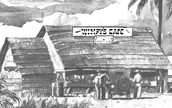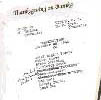
|
|
|
|
|
|
|
Banika (and Pavuvu), Russell (or Russel) Islands
 |
 |
For starters: There is no clear apparent authority or consensus about the usage of RUSSEL vs. RUSSELL. For that matter, no one even seems to acknowledge the discrepancy. Google search for "Russel" assumes Russell. "Search within results" with "Russel" in quotation marks does yield one el. But all results appear to favor one use or the other without further comment
Russells Captured February 16, 1943 (OPERATION
CLEANSLATE)
Army Account and Map of Invasion
Banika map:
http:www.army.mil/cmh-pg/books/wwii/GuadC/p353.GIF;
Battle for Russells:
www.army.mil/cmh-pg/books/wwii/GuadC/GC-EPL.htm (p.
351-356)
Marine Raiders: account and map of invasion - Army on
Banika, Marine Raiders on Pavuvu
http://www.usmarineraiders.org/ng_russell.htm
Reduction and Resurrection on Rabaul
The convenient bays and rivers and relatively even terrain of the Russell Islands in the Solomons, just above Guadalcanal, were providing the Japanese with needed cover, while they could be bringing Munda within Allied striking range.
The invasion took place February 16, 1943. Although Banika was captured by the Army, it was to be developed as a Naval base, while Pavuvu would be captured and held for use of Marine ground troops. The anticipated opposition never materialized, everlastingly annoying Marine Raiders who were better equipped to kill Japanese than to convert Pavuvu's squalid, mosquito-infested swamp into a "rest camp." Pavuvu's contribution to the war was immortalized by Harpers in the October 1949 article, "They called it a rest camp: The First Marine Division on Pavuvu" by George McMillan.
The Navy was far more pleased with Banika where the ground was solid and well drained, and waterways were navigable and camouflaged. Construction of air strips and buildings, docking and unloading facilities, and establishment of bases for flight and ground crews, PT squadrons, were rapidly completed by the Seabees..
Bob Conner reports that he could still see the peaks of Guadalcanal as the 93rd prepared to disembark at their first "Island X" on the eve of Armistice Day, 1943. The USS Perida's passengers were greeted with a hail of coconuts from the welcoming troops.
The Russells had been captured in February and Banika was already an established base when the 93rd Seabees arrived. Outfits newly arrived in the tropics generally were not directed into combat areas until they had a chance to adjust to the climate, lifestyle, and to the demands of wartime construction.
By the time the 93rd arrived, Banika was in the throes of a construction boom that would transform it from an Advanced Naval Base focused on conquering Munda and New Georgia to an Advanced Base Construction Depot (ABCD), stocking and supplying equipment and materials for the advancing troops in the north. The stevedores of the 6th, 9th and other Special Construction Battalions were arriving to unload the Cassiopeia and other ships transporting supplies along the route from the US to the most advanced bases.
The 93rd lost no time, erecting a 1300 bed hospital for MOB 10, creating
a ready-mix concrete plant, and establishing a pontoon assembly depot for
the 2nd Seabee Pontoon Assembly Detachment (PAD-2).
www.ibiblio.org/hyperwar/USN/Building_Bases/bases-25.html p. 257
Four hospitals arose, providing for recouperation of sick and mildly wounded troops expected to return to their commands, temporary care for those permanently out of the war, and emergency and stabilization treatment for severely wounded before evacuation to the States.
Fred Krock, MD,
U.S. Naval Reserve was among the
physicians, and Helen Weant of the 13th AAF 801st Medical Evacuation
Squadron nursed the injured on their flights. Bob Conner spent his
first Christmas oversees in one of the hopspitals and Pilot Herb Sunderman used his recouperation time drawing
http://www.pilotartist.com/Herb_sunderman_WWII_Page_3.html
Pre-war Banika was a copra plantation and cattle feeding station for
Lever Brothers. A small Christianized native population provided labor.
Seabees93 has been unable to determine where the natives were by the
time of the Allied invasion.
The Japanese had maintained only a minimal presence, mostly as a hiding place for ships in transit. At some point, they brought crabs in hopes of establishing them as a crop. Bob Conner reports rather vividly that they blanketed the beach in some places. The free-roaming cattle were occasionally hit by planes, and supplied Wimpy's Hamburger Stand at the airstrip.
A tragedy of the war effort that endures to this day has been the destruction of the abundant forests of both islands, due to extensive logging both during and after the war, when the islands reverted back to Lever Brothers.
Outfits based on Banika and Pavuvu
Naval Construction Battalions (Seabees)
 |
NEWSPAPERS produced by and for Seabees at Camps Endicott and Parks, and overseas. The Commemorative edition of SEABEES lists all Battalions and their wartime assignments. The August 29 edition shows the location of all Battalions at the end of the war. |
Building the Navy's Bases in WWII: History of the Bureau of
Yards and Docks and the Civil Engineer Corps, 1940-1946: A history of
the Pacific war, islands and contributions of individual Seabee battalions.
http://ibiblio.net/hyperwar/USN/Building_Bases/index.html
Appendix lists all Seabees Battalions and their assignments
http://ibiblio.net/hyperwar/USN/Building_Bases/bases-25.html
Individual Battalions based on Banika
20th NCB Section 2 arrives to operate ABCD Annex, January 1944
20th NCB, Section 1arrives in June 1944
24th NCB March 1 44 began construction.
33rd Battalion arr 2-21-43 to
35th Battalion, arr early March 1943
34th NCB - 200 men and heavy equipment @ March 1943
36th NCB 9-43
87th NCB photos - look for the Aurelio Tassone drawing
http://freepages.genealogy.rootsweb.ancestry.com/~tqpeiffer/Documents/MILITARY%20%20Vets%20-%20Units/Military%20Units/Photo%20Archive/87th%20Naval%20Const.%20Btln/
PHOTOS%20and%20IMAGES%20OF%20THE%2087th%20U.S.%20NAVAL%20CONSTRUCTION%20BATTALION%20SEABEEs.html
| 93rd Naval Construction Battalion:
11/11/43-2,3/44 History of the 93rd Seabees Bob Conner's Diary, etc Memoirs of the 93rd Seabees |
 |
| 6th Special Naval Construction Battalion:
stevedoring: Section 2 attached to 4th Marine Advanced Depot on Banika: 10/20-12/19/43 Battalion History Landing in the Philippines: Excerpt from Forthcoming book by Frank Jardin Photos of 6th Special Seabees 6th Special Websites 6th Special NCB Website http://carol_fus.tripod.com/navy_hero_6th_ncb.html |
 |
 |
9th Special Naval Construction Battalion *A Company with some headquarters personnel 10/1/43 - 11/20/43 *various crews 12/44-2/45 *3 of 4 (A, B, C, D) Companies, with Headquarters staff: 2/27/45-war's end. Jennifer Smith believes C Company Gang 24 remained in Green to end of war. Battalion History |
| 11th Special: NCB arrive early 1944 |
 |
12th (Special) early 1944: not on map
ACORN
15 Mess hall, Bougainville, May 9, 1944
PAD 2: 12-43 (depot constructed by 93rd Seabees: 11-43).
CBD 1054 summer 1944.
first CBMU arr 9-43
CBMUs 503:
CBMU 571:
CBMU, 572:
CBMU 573:
CBMU 501:
CBMU 580: arr 1944
CBMU 503: 1944-Jan 1945
CBMU 501: 1-45
CBMU 550: (replace CBMU 503) Jan 1945-
Early 1943 (4 months): CBMUs dismantling and salvaging
MOB 10 dismantled early 1943
Regular Navy
USS Cassiopeia: Ship's History
David
Frederich's Memoirs
USS Rochamborn
PT Base: Bob Conner described it as "lousey with PT boats"," living in trees" and crabs
Must have been Black cats,
Marines on Banika and Pavuvu
VMF -121:
arr mid-June describes
"primitive, cramped airfield at Banika, "advanced base Knucklehead"
http://www.acepilots.com/usmc_porter.html
VMF(N)-531
http://www.nps.gov/archive/wapa/indepth/extcontent/usmc/pcn-190-003121-00/sec4.ht Russell Islands, ComAirSols fighter and strike aircraft
Marines Dive Bombers
1st Marine Division
Navaho Code Talker Harry Benally December 1944
http://www.lapahie.com/NavajoCodeTalker_Right.cfm
http://www.lapahie.com/Harry_Benally.cfm
Marines on Pavuvu
http://www.warriorsinc.com/cfblog/month_blogs.cfm?m=9&y=2007
VMF -121:
arr mid-June
Army Air Force
|
13th Army Air Force excerpts from The Jungle Air Force: AAF-13 42nd Bombardment Group (M), 3 ground echelons leave 15 January and 1 February 1944, 2 remain |
 |
 |
Helen Weant, Flight nurse 801st Medical Evacuation Squadron,
|
Regular Army
37th Infantry Division United
States Army, capture of Banika: 2-16-43
The 14th Infantry arr 7 Jun 43,
21 February, 1943: Marines (3d Marine Raider Battalion and 10th Defense Battalion detachment) and Army troops (elements of the 43rd Division) occupy Russell Islands in Operation CLEANSLATE, the inaugural movement through the central Solomons. Supported by TU 62.7.2 (Captain Ingolf N. Kiland), the landings are made with no opposition. Four light cruisers and four destroyers of TF 68 (Rear Admiral Aaron S. Merrill) and Henderson Field, Guadalcanal-based Saratoga (CV-3) Air Group provide cover.
5 April, 1943: Destroyer O'Bannon (DD-450) sinks Japanese submarine RO 34 near Russell Islands
15 May, 1943: Naval Advanced Base and Naval Air Facility, Russell Islands, Solomons, are established.